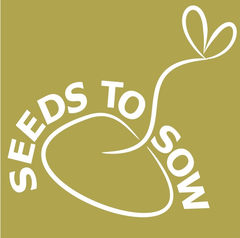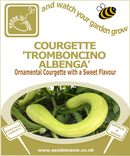Description
Courgette 'Tromboncino Albenga' is a fun and popular Italian heritage summer courgette which can produce long, curled, ornamental fruit (up to 1 metre long but best harvested when they are 30cm long). It has a sweeter flavour than other courgettes and the long neck is always free of seeds.
Perfect for growing where space is limited, as they can be grown in large pots or containers and trained vertically up a trellis, arch or other support. An easy and versatile vegetable for grilling, roasting, frying and also for putting a crunch into salads.
| When to sow | April to May indoors or in a greenhouse, May to June outdoors. |
| Where to Sow | If sowing indoors fill a 7.5cm (3in) pot with compost, firm down and sow 1 seed per pot 2.5cm (1 in) deep. When sowing place the seed on its side. Keep soil moist at all times but do not over water. |
|
If sowing outdoors, sow direct into the final growing position either in a seed bed or in a large pot or container and place where the plant will have plenty of room to trail and climb (up a trellis, fence etc). Ensure that each plant is 1m, in each direction, from its nearest neighbour. Sow seeds on their sides 2.5cm (1 in) deep, placing 2 seeds at each station, which will be thinned out later ensuring that the strongest seedling survives. If there is still a risk of frost in your area cover seed with a cloche. Keep soil moist at all times but do not over water. |
|
| What to do Next | Once the seedling has its first pair of leaves and a third leaf is just appearing, transplant into a larger pot. Harden off the plants for 7 to 10 days before planting them outside in their final growing position (once the risk of frost has passed). |
| For seeds which were planted outside , thin seedlings to one plant per station. | |
| Protect succulent young growth from slugs and snails. | |
| Continue to water regularly, particularly once the plants are in flower and then when the fruits have started to swell. | |
| Regularly harvest the Courgette fruits to encourage more growth. | |
| Harvest | July to October. |
| Handy Tips | Courgettes have both male and female flowers, with the female bearing the fruit once it has been pollinated by the pollen from the male flower. To encourage pollination it is advisable to plant 2 to 3 courgette plants (each plant will produce up to 20 fruit) at a time and then leave the rest to the bees. |
| As courgettes are heat loving plants, a pot or container in the warmest spot on the patio is one of the best places to grow courgettes and you won't be disappointed with their beautiful yellow flower displays in the height of summer. | |
| The more you pick, the more you will grow! Harvest the courgette by cutting away at the stem with a sharp knife when they are between 10 -20cm long. If you leave off harvesting, the courgettes will grow as big as 25-35 cm. This takes more energy from the plant and you will not harvest as many courgettes. | |
| Fruits that directly touch the soil can rot in wet weather so it is advisable to mulch with straw around the base of the plant. | |
| The leaves of the courgettes are susceptible to powdery mildew therefore remove any infected leaves as soon as they appear. | |
| Companion Planting | Calendula (Pot Marigold), Nasturtiums, Radishes, Garlic, Beans and Peas. |
| Nutritional Information | Courgettes are very healthy and contain lots of Vitamin B and C as well as Calcium, Iron and Phosphate. |
| Serving Suggestion | Courgettes are extremely versatile and can be baked, grilled, steamed, stewed, roasted, stir fried or eaten raw. Served simply roasted with a topping of grated Parmesan cheese, garlic and seasoning is absolutely delicious. The flowers are also edible and can be stuffed with cream cheese, battered and deep fried. |
Payment & Security
Your payment information is processed securely. We do not store credit card details nor have access to your credit card information.




